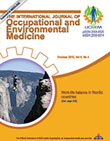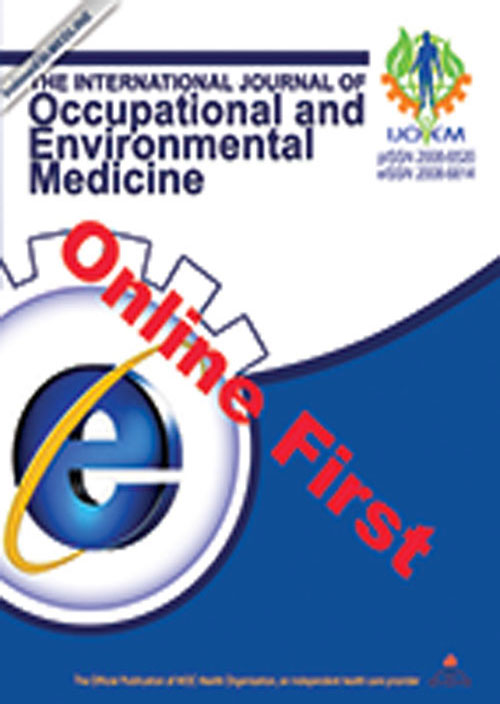فهرست مطالب

International Journal of Occupational and Environmental Medicine
Volume:6 Issue: 4, Oct 2015
- تاریخ انتشار: 1394/12/02
- تعداد عناوین: 9
-
-
Pages 182-204BackgroundThere is controversy surrounding the impact of workplace interventions aimed at improving social support and supervisory quality on absenteeism, productivity and financial outcomes.ObjectiveTo determine the value of social support interventions for work outcomes.MethodsDatabases were searched for systematic reviews between 2000 and 2012 to complete a synthesis of systematic reviews guided by the PRISMA statement and the IOM guidelines for systematic reviews. Assessment of articles for inclusion and methodological quality was conducted independently by at least two researchers, with differences resolved by consensus.ResultsThe search resulted in 3363 titles of which 3248 were excluded following title/abstract review, leaving 115 articles that were retrieved and underwent full article review. 10 articles met the set inclusion criteria, with 7 focusing on social support, 2 on supervisory quality and 1 on both. We found moderate and limited evidence, respectively, that social support and supervisory quality interventions positively impact workplace outcomes.ConclusionThere is moderate evidence that social support and limited evidence that supervisory quality interventions have a positive effect on work outcomes.Keywords: Social support, Efficiency, Absenteeism, Workplace, Outcome assessment (health care)
-
Pages 205-222BackgroundLittle attention has been given to the relationship between work-life balance and sickness absence.ObjectiveTo investigate the association between poor work-life balance and sickness absence in 4 Nordic welfare states.MethodsMultivariable logistic regression analysis was performed on pooled cross-sectional data of workers aged 1565 years from Denmark, Finland, Sweden, and Norway (n=4186) obtained from the 2010 European Working Conditions Survey (EWCS). Poor work-life balance was defined based on the fit between working hours and family or social commitments outside work. Self-reported sickness absence was measured as absence for ≥7 days from work for health reasons.ResultsPoor work-life balance was associated with elevated odds (OR 1.38, 95% CI 1.06 to 1.80) of self-reported sickness absence and more health problems in the 4 Nordic countries, even after adjusting for several important confounding factors. Work-related characteristics, ie, no determination over schedule (OR 1.26, 95% CI 1.04 to 1.53), and job insecurity (OR 1.56, 95% CI 1.21 to 2.02) increased the likelihood of sickness absence, and household characteristics, ie, cohabitation status (OR 0.75, 95% CI 0.58 to 0.96) reduced this likelihood. The associations were non-significant when performed separately for women and men.ConclusionSickness absence is predicted by poor work-life balance. Findings suggest the need for implementation of measures that prevent employee difficulties in combining work and family life.Keywords: Sick leave, Workplace, Family, Denmark, Finland, Sweden, Health planning, Norway, Scandinavian, Nordic countries
-
Pages 223-231BackgroundWorkplace safety has been a concern of workers and managers for decades. Measuring safety climate is crucial in improving safety performance. It is also a method of benchmarking safety perception.ObjectiveTo develop and validate a psychometrics scale for measuring nurse's safety climate.MethodsLiterature review, subject matter experts and nurse's judgment were used in items developing. Content validity and reliability for new tool were tested by content validity index (CVI) and test-retest analysis, respectively. Exploratory factor analysis (EFA) with varimax rotation was used to improve the interpretation of latent factors.ResultsA 40-item scale in 6 factors was developed, which could explain 55% of the observed variance. The 6 factors included employee's involvement in safety and management support, compliance with safety rules, safety training and accessibility to personal protective equipment, hindrance to safe work, safety communication and job pressure, and individual risk perception.ConclusionThe proposed scale can be used in identifying the needed areas to implement interventions in safety climate of nurses.Keywords: Nurses, Safety climate scale, Reliability, Validity, Questionnaire
-
Pages 232-242BackgroundThe Job Content Questionnaire (M-JCQ) is an established self-reported instrument used across the world to measure the work dimensions based on the Karasek's demand-control-support model.ObjectiveTo evaluate the psychometrics properties of the Malay version of M-JCQ among nurses in Malaysia.MethodsThis cross-sectional study was carried out on nurses working in 4 public hospitals in Klang Valley area, Malaysia. M-JCQ was used to assess the perceived psychosocial stressors and physical demands of nurses at their workplaces. Construct validity of the questionnaire was examined using exploratory factor analysis (EFA). Cronbach's α values were used to estimate the reliability (internal consistency) of the M-JCQ.ResultsEFA showed that 34 selected items were loaded in 4 factors. Except for psychological job demand (Cronbach's α 0.51), the remaining 3 α values for 3 subscales (job control, social support, and physical demand) were greater than 0.70, indicating acceptable internal consistency. However, an item was excluded due to poor item-total correlation (rConclusionThe M-JCQ is a reliable and valid instrument to measure psychosocial and physical stressors in the workplace of public hospital nurses in Malaysia.Keywords: Job content questionnaire, Validity, Reliability, Nurses, Malaysia
-
Pages 243-246Occupational hazards, exposure to blood and body fluids (BBF) accidents and safety precautions constitute an important public health issue. We assessed the prevalence and determinants of exposure to occupational hazards among nurses, and their knowledge of occupational safety precautions. In a cross-sectional study, we surveyed 332 nurses working in 4 hospitals, Nablus, West Bank, Palestine, by a questionnaire. Bivariate analysis tested the associations between ever exposure and the high likelihood of BBF exposure and the independent socio-demographic and occupational variables. Binary logistic regression analysis was used to assess the associations between the same two exposures and selected independent variables (those significant in the bivariate analysis). Prevalence of ever exposure to BBF was 51.7%, and was associated with working in private and charitable hospitals (OR 2.62, 2.68, respectively), having 46 family members (OR 0.52) and nursing being as one's top career choice at university (OR 0.48). The prevalence of high likelihood of BBF exposure was 62.2%, and was associated with working in charitable and private hospitals (OR 7.81, 2.43, respectively) and nursing being as one's top career choice (OR 0.57). Regarding knowledge, most respondents believed it is necessary to enact laws and regulations regarding occupational safety precautions, reported the use of sharps containers, immediate disinfection after an accident, reporting an accident, and using personal protective equipment. Nurses had adequate knowledge of the risks of their hospital work. Nevertheless, they exhibited high prevalence of exposure to BBF accidents. Future studies are needed to re-evaluate existing occupational safety guidelines in hospitals, establish monitoring and evaluation protocols for health care worker's adherence to the guidelines, and institute well-defined policies for reporting occupational injury incidents so these can be handled appropriately.Keywords: Occupational safty, Occupational exposure, Nurses, Blood safety, Body fluids, Health knowledge, attitudes, practice, Palestine
-
Pages 247-248
-
Page 250
-
A Note of ThanksPage 251


